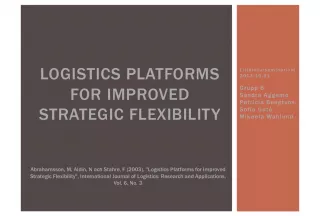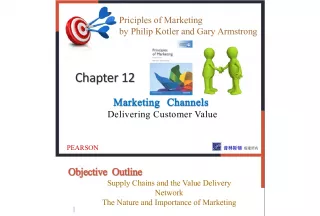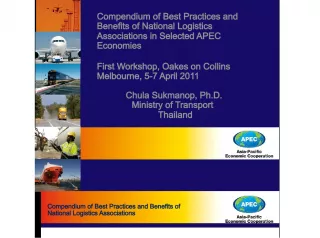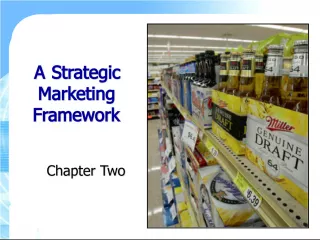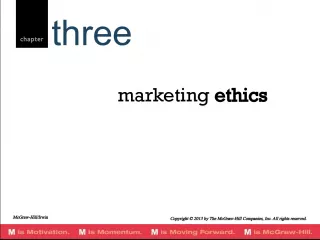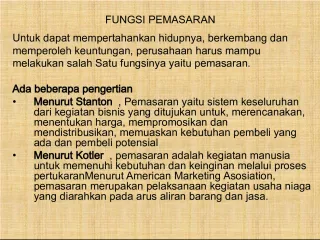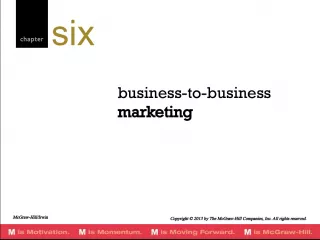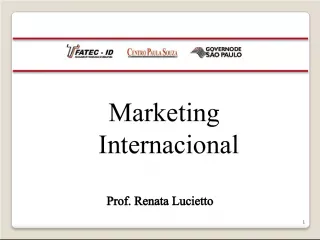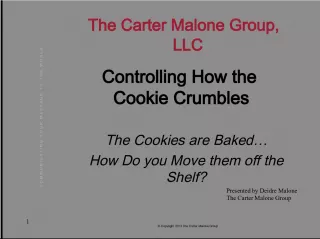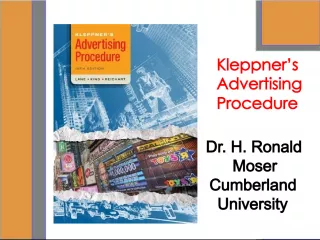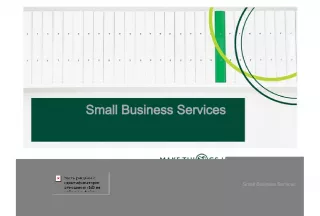Marketing Intermediaries in Retailing, Wholesaling, and Logistics
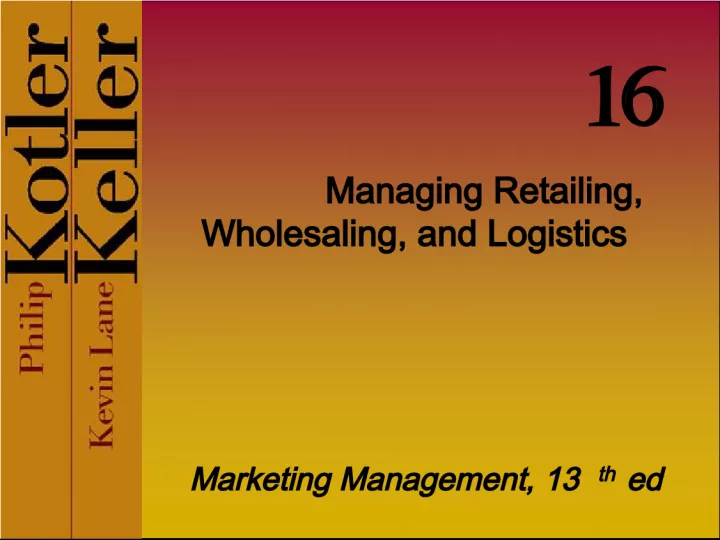

This chapter explores the different types of marketing intermediaries in the retail, wholesale, and logistics sectors and the decisions they make. It also discusses the major trends in marketing intermediaries.
- Uploaded on | 1 Views
-
 femina
femina
About Marketing Intermediaries in Retailing, Wholesaling, and Logistics
PowerPoint presentation about 'Marketing Intermediaries in Retailing, Wholesaling, and Logistics'. This presentation describes the topic on This chapter explores the different types of marketing intermediaries in the retail, wholesale, and logistics sectors and the decisions they make. It also discusses the major trends in marketing intermediaries.. The key topics included in this slideshow are retailing, wholesaling, logistics, marketing management, intermediaries,. Download this presentation absolutely free.
Presentation Transcript
1. Managing Retailing, Wholesaling, and Logistics Marketing Management, 13 th ed 16
2. Copyright 2009 Pearson Education, Inc. Publishing as Prentice Hall 16-2 Chapter Questions What major types of marketing intermediaries occupy this sector? What marketing decisions do these marketing intermediaries make? What are the major trends with marketing intermediaries?
3. Copyright 2009 Pearson Education, Inc. Publishing as Prentice Hall 16-3 ZARA Places Retail Stores in High-End, High Traffic Areas
4. Copyright 2009 Pearson Education, Inc. Publishing as Prentice Hall 16-4 What is Retailing? Retailing includes all the activities involved in selling goods or services directly to final consumers for personal, nonbusiness use.
5. Copyright 2009 Pearson Education, Inc. Publishing as Prentice Hall 16-5 Table 16.1 Major Retailer Types Specialty store Department store Supermarket Convenience store Discount store Off-price retailer Superstore Catalog showroom
6. Copyright 2009 Pearson Education, Inc. Publishing as Prentice Hall 16-6 Levels of Retail Service Self-service Self-selection Limited service Full service
7. Copyright 2009 Pearson Education, Inc. Publishing as Prentice Hall 16-7 Figure 16.1 Retail Positioning Map
8. Copyright 2009 Pearson Education, Inc. Publishing as Prentice Hall 16-8 Nonstore Retailing Direct selling Buying service Automatic vending Direct marketing
9. Copyright 2009 Pearson Education, Inc. Publishing as Prentice Hall 16-9 Table 16.2 Major Types of Corporate Retail Organizations Corporate chain store Voluntary chain Retailer cooperative Consumer cooperative Franchise organization Merchandising conglomerate
10. Copyright 2009 Pearson Education, Inc. Publishing as Prentice Hall 16-10 Corporate Retailing
11. Copyright 2009 Pearson Education, Inc. Publishing as Prentice Hall 16-11 What is a Franchising System? A franchising system is a system of individual franchisees, a tightly knit group of enterprises whose systematic operations are planned, directed, and controlled by the operations franchisor.
12. Copyright 2009 Pearson Education, Inc. Publishing as Prentice Hall 16-12 Characteristics of Franchises The franchisor owns a trade or service mark and licenses it to franchisees in return for royalty payments The franchisee pays for the right to be part of the system The franchisor provides its franchisees with a system for doing business
13. Copyright 2009 Pearson Education, Inc. Publishing as Prentice Hall 16-13 Quiznos is a Franchising System
14. Copyright 2009 Pearson Education, Inc. Publishing as Prentice Hall 16-14 Changes in the Retail Environment New retail forms and combinations Growth of intertype competition Competition between store-based and non-store-based retailing Growth of giant retailers Decline of middle market retailers Growing investment in technology Global profile of major retailers
15. Copyright 2009 Pearson Education, Inc. Publishing as Prentice Hall 16-15 New Retail Forms and Combinations Combination retailers Pop-ups Showcase stores
16. Copyright 2009 Pearson Education, Inc. Publishing as Prentice Hall 16-16 Retailers Marketing Decisions Target market Product assortment Procurement Prices Services
17. Copyright 2009 Pearson Education, Inc. Publishing as Prentice Hall 16-17 Retailers Marketing Decisions (cont.) Store atmosphere Store activities Communications Locations
18. Copyright 2009 Pearson Education, Inc. Publishing as Prentice Hall 16-18 Retail Category Management Define the category Figure out its role Set goals Choose the audience Implement the plan Figure out tactics Assess performance
19. Copyright 2009 Pearson Education, Inc. Publishing as Prentice Hall 16-19 Direct Product Profitability
20. Copyright 2009 Pearson Education, Inc. Publishing as Prentice Hall 16-20 Retailer Services Mix Prepurchase services Postpurchase services Ancillary services
21. Copyright 2009 Pearson Education, Inc. Publishing as Prentice Hall 16-21 Store Atmosphere Walls Lighting Signage Product placement Floors Surface space Music The Fornarina flagship store features award-winning retail design.
22. Copyright 2009 Pearson Education, Inc. Publishing as Prentice Hall 16-22 Tips for Increasing Sales in Retail Space Keep shoppers in the store Honor the transition zone Dont make them hunt Make merchandise available to the reach and touch Note that men do not ask questions Remember women need space Make checkout easy
23. Copyright 2009 Pearson Education, Inc. Publishing as Prentice Hall 16-23 Location Decision Central business districts Regional shopping centers Community shopping centers Shopping strips Location within a larger store
24. Copyright 2009 Pearson Education, Inc. Publishing as Prentice Hall 16-24 Indicators of Sales Effectiveness Number of people passing by % who enter store % of those who buy Average amount spent per sale
25. Copyright 2009 Pearson Education, Inc. Publishing as Prentice Hall 16-25 Private Labels
26. Copyright 2009 Pearson Education, Inc. Publishing as Prentice Hall 16-26 Private Label Brands Private labels are ubiquitous Consumers accepts private labels Private-label buyers come from all socioeconomic strata Private labels are not a recessionary phenomenon Consumer loyalty shifts from manufacturers to retailers
27. Copyright 2009 Pearson Education, Inc. Publishing as Prentice Hall 16-27 Wholesaling Functions Selling and promoting Buying and assortment building Bulk breaking Warehousing Transportation Financing Risk bearing Market information Management services and counseling
28. Copyright 2009 Pearson Education, Inc. Publishing as Prentice Hall 16-28 Major Wholesaler Types Merchant Full-service Limited-service Brokers and agents Manufacturers Specialized
29. Copyright 2009 Pearson Education, Inc. Publishing as Prentice Hall 16-29 Market Logistics Planning Deciding on the companys value proposition to its customers Deciding on the best channel design and network strategy Developing operational excellence Implementing the solution
30. Copyright 2009 Pearson Education, Inc. Publishing as Prentice Hall 16-30 What are Integrated Logistics Systems? An integrated logistics system (ILS) includes materials management, material flow systems, and physical distribution, aided by information technology.
31. Copyright 2009 Pearson Education, Inc. Publishing as Prentice Hall 16-31 Market Logistics Sales forecasting Distribution scheduling Production plans Finished-goods inventory decisions Packaging In-plant warehousing Shipping-room processing Outbound transportation Field warehousing Customer delivery and servicing
32. Copyright 2009 Pearson Education, Inc. Publishing as Prentice Hall 16-32 Market Logistics Decisions How should orders be handled? Where should stock be located? How much stock should be held? How should goods be shipped?
33. Copyright 2009 Pearson Education, Inc. Publishing as Prentice Hall 16-33 Figure 16.2 Determining Optimal Order Quantity
34. Copyright 2009 Pearson Education, Inc. Publishing as Prentice Hall 16-34 Transportation Factors Speed Frequency Dependability Capability Availability Traceability Cost
35. Copyright 2009 Pearson Education, Inc. Publishing as Prentice Hall 16-35 Containerization
36. Copyright 2009 Pearson Education, Inc. Publishing as Prentice Hall 16-36 Marketing Debate Should national brand manufacturers also supply private label brands? Take a position: 1. Manufacturers should feel free to sell private labels as a source of revenue. or 2. National manufacturers should never get involved with private labels .
37. Copyright 2009 Pearson Education, Inc. Publishing as Prentice Hall 16-37 Marketing Discussion Think of your favorite stores. What do they do that encourages your loyalty? What do you like about the in-store experience?

